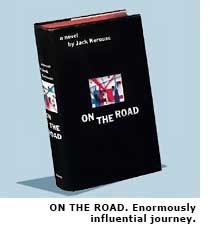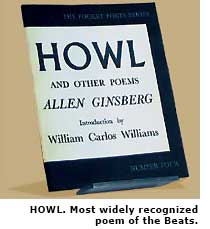Bohemia by the Bay: Looking Back on the Beat Generation - Page 4
The Six Gallery in San Francisco's Marina neighborhood, west of North Beach, was a memorable site for Michael McClure to render the first public reading of his poetry, in October 1955. New to the city, to which he'd come to study art with abstract expressionist Clyfford Still, McClure had been asked to assemble a reading at the Gallery, a former garage that had become devoted to the visual arts.
McClure enlisted his new friend, Allen Ginsberg, to help recruit poets, who included Philip Whalen, Gary Snyder, and Philip Lamantia, with elder poet and long-time San Francisco resident Kenneth Rexroth functioning as emcee. The event is best remembered for Ginsberg's introduction of his long, passionate poem 'Howl,' cheered on by an inebriated Jack Kerouac.
McClure's own first book of poetry was published a year later, and he went on to produce many others, suffused with his animalistic approach to the human condition. (He considered people to be "bags of meat" and performed one of his readings for the lions at the San Francisco Zoo.)
Despite this call to the wild, McClure had a benign nature that was easily embraced, in the latter part of the '60s, by the Hippies. Like Ginsberg, McClure stood up to authorities, who accused him of depicting obscene acts in his play 'The Beard.'
McClure served as playwright-in-residence at San Francisco's Magic Theatre, penned the song 'Mercedes Benz' (made popular by Janis Joplin), and was acknowledged as a poetic mentor to Doors songwriter Jim Morrison.

6. ON THE ROAD
Jack Kerouac wrote his chef d'oeuvre, 'On the Road,' in 1951, before the acknowledged emergence of the Beat culture, and set the start date of the narrative in 1947. But the incubation of the Beats was already in process by the earlier date, with the coming together in New York City of Kerouac, fellow writers Allen Ginsberg and William Burroughs, and the charismatic soldier of fortune, Neal Cassady. The foursome is featured in the Viking Press first printing of 'On the Road' (1957) under fictitious names.
Despite the pseudonyms (which incidentally weren't used in Kerouac's original manuscript, typed over a period of three weeks on a continuous scroll of tracing paper), many of the novel's events were based on the real-life experiences of Kerouac and his friends and acquaintances that took place during the period that the Beat culture was coalescing.
The book's title references four journeys made by Kerouac across the U.S. and Mexico, some in the company of Cassady. Cassady inspired Kerouac not only as a vital fellow traveler but also because of his own literary style: natural, without traditional literary affect, and forthright in recounting sexual adventures.
Although some of the racier episodes and the real names of the protagonists were edited out by Kerouac before the initial publication, they were mostly restored, 38 years after the author's death, for 'The Original Scroll' edition of the book, published in 2007.
Still, enough salaciousness remained in the first published edition of 'On the Road' in 1957, along with accounts of a marijuana-fueled foray into Mexico, to garner plenty of positive and negative reactions from Beats and the wider reading public. The book helped reinforce images of the Beats in general, and San Francisco (one of the featured locales) in particular, and was enormously influential on later writers.

7. HOWL
Arguably the most widely recognized poem from the Beat era, and an enduring landmark in 20th century American literature, 'Howl' was revised several times by its creator, Allen Ginsberg, right up to the point of his first public reading of it at San Francisco's Six Gallery in 1955.
Ginsberg had written the long poem at his cottage in Berkeley at the urging of his therapist and of his poetic mentor, Kenneth Rexroth, while devoting himself to writing full time and striving to free his voice. He found models of expression in William Carlos Williams and in his fellow New York expatriate Jack Kerouac, but set out to create his own form of versifying, based on the repetition of key words and the basing of line lengths on the rhythms of breathing.
This incantatory form, somewhat evocative of Jewish liturgical text, supported the content of 'Howl,' which bemoaned the repression of a variety of counter-culture characters. In one of the poem's four sections, Ginsberg, inspired by an episode of peyote-fueled visualization, rails against the monster of contemporary materialism.
During the Six Gallery reading, the poets and others who were assembled recognized the passion and uniqueness of Ginsberg's vision, as did Lawrence Ferlinghetti, who set about publishing 'Howl and Other Poems,' and a reporter from the 'New York Times,' who gave the poem national exposure.




